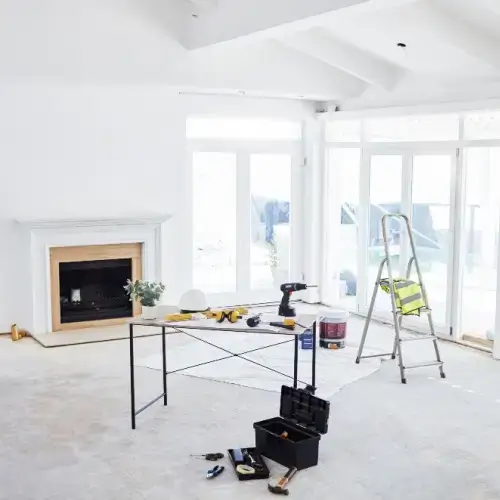Home / Home Loans / Your guide to home renov…

Key takeaways
- If you’re looking for a way to pay for planned home improvements, there are a few different loan options available to you.
- While a ‘renovation loan’ isn’t available as a stand-alone product, you can use different types of home loans and solutions to fund renovations.
- Considering your financial situation can help you decide which of these options might be best suited to your wants and needs.
Expert tips for deciding on a renovation loan
Our General Manager of Money, Stephen Zeller, has some tips for prospective borrowers trying to decide how to bankroll their renovation project:

Figure out the scope of your planned upgrades
If you haven’t already, working out the approximate scale of the work you want done could help you decide how you want to go about paying for it. Think about how long the work is likely to take, whether it’s interior, exterior, or both, and how substantially it will modify the existing property.
Think about what product type might best suit you
Once you know exactly what work is on the cards, you can start thinking about which type of renovation loan solution might be most appropriate for your planned renovations. For example, if they’re relatively more minor, you might decide to fund them via your redraw account, whereas taking out a new loan or refinancing could be a more suitable option if they’re on a larger scale.
Refinancing? We can help with that!
If you’ve decided that refinancing will be the best next step towards your dream home, don’t just refinance to the first home loan you find! Our online home loan comparison tool lets you do a side-by-side comparison of your options, and could potentially help you find a better home loan deal.
The different types of “renovation loans”
While a renovation loan isn’t a specific type of loan that you can take out, there are several loan options available to property owners looking to fund future renovations.
Tap into your existing home equity

If you’ve had your home loan for a while and have been making regular home loan repayments, you may have built up enough equity in your home to borrow against. You could do this either via refinancing (more on that later), or a line of credit.
A line of credit is a home loan feature that gives you the ability to borrow back money you’ve paid off your home loan. It’s a bit like a credit card, but your borrowing limit is tied to how much of your home loan you’ve paid off. Keep in mind that reducing your equity will mean owning less of your property than you did before, and an increase in your home loan repayments.
Use your redraw facility
If you’ve got a variable rate home loan with a redraw facility, you could draw on the funds you’ve built up there. This is similar to accessing existing equity, but a redraw facility will only let you access any extra home loan repayments you’ve made.
Another important point to keep in mind is that accessing your redraw facility will make your home loan repayments larger. Be sure to think about whether you’d be able to afford those larger home loan repayments if you did take money out of your redraw facility. You may also have to pay an upfront fee per redraw made.
Refinance your home loan
If you have the necessary equity, refinancing your home loan could be a handy way to access the funds needed for your renovations. Refinancing can also be a useful debt consolidation tool, letting you roll a personal loan or credit card debt you’re your home loan’s lower interest rate.
Whether you choose to refinance to a variable or fixed interest rate home loan, keep in mind that the larger your new home loan amount is, the larger your new home loan repayments will be. You may be able to mitigate this by refinancing to the longest loan term possible as the more time you have to pay off the loan, the smaller your monthly repayment amount will be.
Even though you’re refinancing an existing loan, your application will still be subject to the lender’s home loan eligibility criteria and standard application process which will typically include an audit of your finances, credit score and credit history.
Take out a construction loan
If you’re looking to substantially renovate a property or make expensive and significant changes, a construction loan could be an option worth considering.
A construction loan is a type of loan specifically designed to finance the construction of a new home. It differs from most other home loans in that the loan balance is paid progressively in stages to the builder, rather than all at once to a seller.
Additionally, construction loans typically require the borrower to make interest-only repayments during the construction phase. Once the property is built, you’ll revert to regular principal and interest repayments for the remaining life of the loan.
Take out a personal loan
For medium-sized renovations that aren’t large enough to justify refinancing or taking out a construction loan, a personal loan could suit your situation. You might not have enough equity to finance the works outright, but you could have enough to secure a variable or fixed-rate personal loan.
You could also take out an unsecured personal loan, which wouldn’t require you to put up collateral against the loan. However, this could reduce the amount you can borrow, or make you ineligible for more competitive interest rates.
Keep in mind that personal loans will typically come with a higher interest rate than you’d get by refinancing your existing home loan or taking out a new construction loan. Depending on the lender and loan in question, you may also have to pay establishment fees, early repayment fees or a monthly account fee.
Switch to interest-only repayments
Depending on your financial situation and the progress you’ve made towards paying off your home loan, you may be eligible to apply to switch to making interest-only repayments for a set period of time. If a lender offers this option, it will typically offer it to investors and owner-occupiers.
Interest-only repayments will be smaller than principal and interest repayments on the same home loan, meaning that making the switch could potentially free up a significant amount of cash for you on a regular basis. However, it’s important to note that going interest only has two major drawbacks:
- You’ll likely pay more in interest over the life of the loan. This is because you’ll typically have a higher interest rate if you switch to interest-only repayments, and because you’ve delayed paying off any of your home loan principal for the duration of your new interest-only period.
- When your interest-only period ends, your new principal and interest home loan repayments will be even bigger than before you first switched to interest-only repayments. This is because you have the same-sized home loan principal as before, but with less time to pay it off, making for a larger principal component of your repayments.
Your lender will only approve your application to switch to interest-only repayments if they are confident that you’ll be able to afford the larger principal and interest repayments you’d have to make once your interest-only period is over.
Consider speaking to a financial advisor or a mortgage broker about the pros and cons of switching to an interest-only home loan.
Meet our home loans expert, Stephen Zeller
Stephen has more than 30 years of experience in the financial services industry and holds a Certificate IV in Finance and Mortgage Broking. He’s also a member of both the Australian and New Zealand Institute of Insurance and Finance (ANZIIF) and the Mortgage and Finance Association of Australia (MFAA).
Stephen leads our team of Mortgage Brokers, and reviews and contributes to Compare the Market’s banking-related content to ensure it’s as helpful and empowering as possible for our readers.


